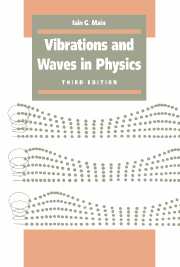Book contents
- Frontmatter
- Contents
- Preface to the first edition
- Preface to the second edition
- Preface to the third edition
- Notes for reference
- 1 Free vibrations
- 2 Free vibrations in physics
- 3 Damping
- 4 Damping in physics
- 5 Forced vibrations
- 6 Forced vibrations in physics
- 7 Anharmonic vibrations
- 8 Two-coordinate vibrations
- 9 Non-dispersive waves
- 10 Non-dispersive waves in physics
- 11 Fourier theory
- 12 Dispersion
- 13 Water waves
- 14 Electromagnetic waves
- 15 De Broglie waves
- 16 Solitary waves
- 17 Plane waves at boundaries
- 18 Diffraction
- Answers to problems and hints for solution
- Constants and units
- Index
13 - Water waves
Published online by Cambridge University Press: 05 June 2012
- Frontmatter
- Contents
- Preface to the first edition
- Preface to the second edition
- Preface to the third edition
- Notes for reference
- 1 Free vibrations
- 2 Free vibrations in physics
- 3 Damping
- 4 Damping in physics
- 5 Forced vibrations
- 6 Forced vibrations in physics
- 7 Anharmonic vibrations
- 8 Two-coordinate vibrations
- 9 Non-dispersive waves
- 10 Non-dispersive waves in physics
- 11 Fourier theory
- 12 Dispersion
- 13 Water waves
- 14 Electromagnetic waves
- 15 De Broglie waves
- 16 Solitary waves
- 17 Plane waves at boundaries
- 18 Diffraction
- Answers to problems and hints for solution
- Constants and units
- Index
Summary
The next three chapters are about waves which are, except in special circumstances, dispersive. For each type of wave we shall find the dispersion relation. When we have found it we shall quarry in it for physics, exploring particularly those extreme forms which can be so instructive.
To most people the word ‘wave’ suggests a stormy sea or ripples on the surface of a pond. Our discussion of these, the most familiar of all waves, falls into three main parts. In the first section we consider the purely geometrical problem of how the water must move in order to make a sinusoidal travelling wave on the surface. Then we find the dispersion relation, which tells us what sinusoidal waves are actually possible: this is a physical problem. Finally we conduct our discussion of the dispersion relation under various interesting extreme conditions.
Most of the physical results are to be found in the third section. If you wish to skip the preliminaries, you should first study fig. 13.5 and its caption, and the summary at the end of section 13.1, and then proceed directly to the dispersion relation (13.19).
The nature of the wave motion
We study the water in a long, rectangular canal of depth h (fig. 13.1). In equilibrium the water surface is flat and horizontal. With luck, a very special kind of breeze might blow along the length of the canal, exciting a sinusoidal travelling wave.
- Type
- Chapter
- Information
- Vibrations and Waves in Physics , pp. 236 - 257Publisher: Cambridge University PressPrint publication year: 1993



